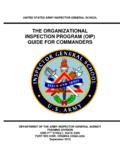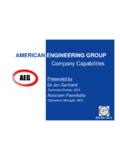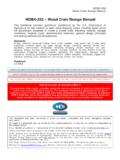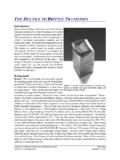Transcription of Domestic Hot Water - Special Events
1 Domestic Hot Water Recirculation James M. Pleasants Company Approved by GBCI for 1 CE Hour Course Approval Number is 0090009310 Domestic Hot Water Recirculation Learning Objectives In this seminar you will learn to: 1. Describe why conserving Water is important. 2. Calculate the recirculation flow rate. 3. identify recirculation trouble areas. 4. Design a recirculation system with a sizing example. 5. Apply Special design considerations for instantaneous Water heater applications. 6. identify ways to balance multiple riser flows. 7. identify ways to recirculate buildings with pressure reducing valve. 2 Building Return Cold Water Supply Lochinvar Armor Condensing Water Heater Constant Flow Pump Balance Valve Recirculation Pump Lock-Temp Storage Tank Drain Building Hot Water Supply Relief Valve Thermal Expansion Tank Backflow Preventor Condensing Water Heater 070709CE 3 Why? 4 Water Egg = 120 gallons 1 kw = 80 gallons 1 ton steel = 65,000 gallons Typical Water Usages Total USA Water usage 1,430 gallons per person per day in 2000 Private Usage Southeast USA 182 gallons per day 5 Water 6 Water covers more than 70% of the earth s surface.
2 About 97% is salty Water 3% fresh Water World Population 1802 1 Billion 2000 6 Billion 2040 9 Billion 7 What Is The Purpose of Hot Water Recirculation? To Conserve Water By Providing Hot Water At The Fixture More Quickly 8 CHAPTER 7 SERVICE Water HEATING Service Water Heating System Controls SECTION Mandatory Provisions Temperature Maintenance Controls. Systems designed to maintain usage temperatures in hot- Water pipes, such as recirculating hot- Water systems or heat trace, shall be equipped with automatic time switches or other controls that can be set to switch off the usage temperature maintenance system during extended periods when hot Water is not required. Outlet Temperature Controls. Temperature controlling means shall be provided to limit the maximum temperature of Water delivered from lavatory faucets in public facility restrooms to 110oF. Circulating Pump Controls.
3 When used to maintain storage tank Water temperature, recirculating pumps shall be equipped with controls limiting operation to a period from the start of the heating cycle to a maximum of five minutes after the end of the heating cycle. 9 Following is from section III, Chapter 7 of OSHA s technical manual. ( #5) 1. Background. Domestic hot- Water systems are frequently linked to Legionnaires' outbreaks. C. Domestic HOT- Water SYSTEMS. 2. Design. Water systems designed to recirculate Water and minimize dead legs will reduce stagnation. 3. Maintenance. c. Domestic hot- Water recirculation pumps should run continuously. They should be excluded from energy conservation measures. Water heaters that are maintained below 60 C (140 F) and contain scale and sediment tend to harbor the bacteria and provide essential nutrients for commensal micro-organisms that foster growth of L. pneumophila.
4 A. To minimize the growth of Legionella in the system, Domestic hot Water should be stored at a minimum of 60 C (140 F) 10 The wife of a Vietnam War Army veteran who died Oct. 23 in Erie believes her husband may have died after contracting Legionnaires' disease from the Water system at the VA hospital in Oakland. If John McChesney, 63, did die after contracting the pnemonia-like disease at the University Drive facility, that potentially makes him the third patient in the past two years to die after getting Legionnaires' disease there. Third vet's death tied to Legionnaires' His wife blames Water from VA hospital in Oakland December 4, 2012 12:11 am By Sean D. Hamill / Pittsburgh Post-Gazette 11 Four Things to Remember about a Hot Water Recirculation System 12 The recirculation flow rate will be established by supply piping heat loss to the farthest faucet or riser at a given delta temperature Number 1 13 Recirculation return line heat loss need not be considered Number 2 14 The required flow to compensate for the heat loss of insulated copper pipe is typically a low GPM flow rate Number 3 15 The recirculation return line will be (most of the time) equal in length to supply main length Number 4 16 Potential recirculation trouble areas are.
5 Water Heater Temperature Control Unbalanced Riser Flows Recirculation with Reducing Valves Recirculation Pump and Its Control Domestic HW recirculation pumps must be constructed so that all working parts exposed to Domestic Water are brass, bronze, stainless steel or non-ferrous in order to resist the corrosive attack of oxygenated fresh Water . Conventional iron body Hydronic System pumps should not be used! 17 Basic Recirculation Design Procedures Determine Required Recirculation Flow Rate. Determine Flow-Friction Head Loss in Recirculation Line, Heater, Supply Pipe and etc. Size Recirculation Line Select Pump Based on Flow Requirement and Head Loss. ( based on heat loss of supply pipe) 18 Apartment Sizing Example 19 Example Problem: Apartment Building Each Apartment Requires FU Eight (8) Apartments per riser and Twelve (12) risers Each Riser 30 FU X 12 Risers = 360 FU 360 FU = 100 GPM There is 25 ft.
6 Between each riser for a total of 300 feet of supply piping 20 12 11 10 9 8 7 6 5 4 3 2 1 30 60 90 120 150 180 210 240 270 300 330 360 Simple Recirculation System Riser # F. U . Count Check Valve CW A Heater B 1 1/4 1 1/2 2 2 1/2 2 2 1/2 Recirculation Pump Recirculation Return Apartment Building Example (Supply pipe 300 feet long) 21 The Heating Load for Hot Water Recirculation Load (BTU/Hr) = GPM x 500 x T What is design temperature Drop? (10o T Good Design) 22 E D C B A Recirculated Main Non-Recirculated Riser Simple Recirculation System with Non-Recirculated Riser; Riser Run-out Length (A, B, C, D, E) Should Not Exceed Approximately 50 Ft. 23 SECTION 607 HOT Water SUPPLY SYSTEM Hot Water supply temperature maintenance. Where the developed length of hot Water piping from the source of hot Water supply to the farthest fixture exceeds 100 feet (30 480 mm), the hot Water supply system shall be provided with a method of maintaining the temperature in accordance with the International Energy Conservation Code.
7 2006 INTERNATIONAL PLUMBING CODE [E] Hot Water system controls. Automatic circulating hot Water system pumps or heat trace shall be arranged to be conveniently turned off, automatically or manually, when the hot Water system is not in operation. Recirculating pump. Where a thermostatic mixing valve is used in a system with a hot Water recirculating pump, the hot Water or tempered Water return line shall be routed to the cold Water inlet pipe of the Water heater and the cold Water inlet pipe or the hot Water return connection of the thermostatic mixing valve. 24 Water closets (toilets) - flushometer valve type CHAPTER 6 Water USE EFFICIENCY TABLE Plumbing Fixtures and Fittings Requirements Appliances Mandatory Provisions Water closets (toilets) - flushometer valve type Water closets (toilets) - tank-type Water closets (toilets) - tank-type Urinals Public lavatory faucets Public metering self-closing faucet Residential bathroom lavatory sink faucets Residential kitchen faucets Residential showerheads Residential shower compartment (stall) in dwelling units and guest rooms Single flush volume of gal ( L) Effective dual flush volume of gal ( L) Single flush volume of gal ( L) Effective dual flush volume of gal ( L) Flush volume of gal ( L) Flow rate - gpm ( L/min) gal ( L) per metering cycle Flow rate - gpm ( L/min) Flow rate - gpm ( L/min) Flow rate - gpm ( L/min)
8 Flow rate from all shower outlets total of - gpm ( L/min) Plumbing Fixture Maximum 25 Low Flow Fixture Problem Public metering self-closing faucet gal ( L) per metering cycle. Will you ever get hot Water if light usage? (.35 ft/sec in a .5 inch copper pipe) Common Problem because of low flow! Shorter Run out lengths? (less 50 ft) Electric heat trace the run outs? 26 Hot Water Distribution Efficient Hot or Tempered Water Distribution Systems. For the purposes of this section, sources of hot or tempered Water include Water heaters, boilers, hot Water circulation loops, and electrically heat-traced pipe. The volume of Water in the piping between Water heaters or boilers and fixture fittings the serve shall not exceed 32 ounces ( L). The volume of Water contained in fixture branch piping that connects to a hot Water circulation loop or electrically heat- traced pipe shall not exceed 16 ounces ( L).
9 The volume shall be calculated in accordance with Table 6-3. BSR/ASHRAE/USGBC/ASPE/AWWA Standard 191P (Public Review Draft) Standard for the Efficient Use of Water in Building, Site, and Mechanical Systems 27 12 11 10 9 8 7 6 5 4 3 2 1 30 60 90 120 150 180 210 240 270 300 330 360 Simple Recirculation System Riser # F. U . Count Check Valve CW A Heater B 1 1/4 1 1/2 2 2 1/2 2 2 1/2 Recirculation Pump Recirculation Return What is heat loss of supply pipe? 28 Temperature Drop 10o 15o 20o BTU/GPM Relationship 5,000 B/Hr. = 1 GPM 7,500 B/Hr. = 1 GPM 10,000 B/Hr. = 1 GPM 1/2 3/4 1 1 1/4 1 1/2 2 2 1/2 3 4 5 6 1600 1800 2000 2400 2600 3000 3400 4000 4800 5700 6600 4,000 5,000 6,000 7,500 8,500 11,000 12,000 15,000 19,000 22,500 26,000 2,300 3,000 4,000 4,500 5,500 6,500 8,000 9,500 12,000 Pipe or Tube Size Insulated Copper Tube or Steel Pipe Non-Insulated Steel Pipe Non-Insulated Copper Pipe BTUH heat loss per 100 ft for tubing and steel pipe.
10 29 Using insulated copper tube, 25 ft. length between riser take-off points, supply line heat loss to the farthest riser take-off is as follows: Heat loss, BTUH B - #1 2-1/2 30 ft. 3400/100 3400 x 30/100 = 1020 #1 - #4 2-1/2 75 ft. 3400/100 3400 x 75/100 = 2550 #4 - #10 2 150 ft. 3000/100 3000 x 150/100 = 4500 #10 - #11 1-1/2 25 ft 2600/100 2600 x 25/100 = 650 #11 - #12 1-1/4 25 ft 2400/100 2400 x 25/100 = 600 TOTAL SUPPLY LINE HEAT LOSS = 9320 BTUH 30 12 11 10 9 8 7 6 5 4 3 2 1 30 60 90 120 150 180 210 240 270 300 330 360 Simple Recirculation System Riser # F. U . Count Check Valve CW A Heater B 1 1/4 1 1/2 2 2 1/2 2 2 1/2 Recirculation Pump Recirculation Return Supply Pipe Heat Loss is 9,320 BTUH 31 Required Water Flow: Water TEMP: 140 DEG From Water Heater 130 DEG At Farthest riser 10 DEG Delta Temperature 1 gpm flow Will Convey 5000 BTUH Recirculation return flow need = 9320 / 5000 = gpm A 3/4 copper line is the proper size selection for gpm The friction loss will be about ft per 100 ft.







